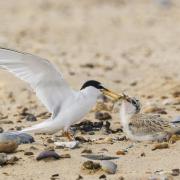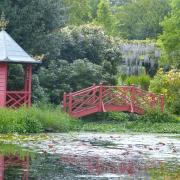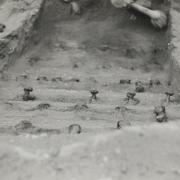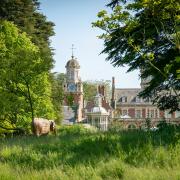Sixty miles of marshland, mudflats, creeks and shingle spits between Lowestoft and Felixstowe - this is the place to blow away the cobwebs, clear your head and draw breath
Suffolk’s coast is beautiful in winter – wild and wonderful with its wind-whipped dunes, dark, rolling North Sea, and foaming waves crashing on the shingle.
This is also the much-loved Suffolk Coast and Heaths Area of Outstanding Natural Beauty, the most easterly part of England and the place to watch the sun rise on a new year. It’s a watery world, where five reed-fringed rivers empty into the North Sea – the Stour, Orwell, Deben, Alde and Blyth. They wend their way through low-lying hinterlands – 170 square miles (441 sq km) of ancient woodland, forest, lowland heaths, farmland, valley meadowlands, estuaries, marshes, and historic market towns and villages.

Without the summer crowds, you’ll have the place to yourselves (well, almost!). So, wrap up warm, pull on your boots and beanie, and get out and explore. If you enjoy a bracing seaside walk this is the place to be. Find peace and quiet in the forests, or enjoy the chatter of thousands of birds wading and wandering over the shimmering estuary mudflats.
If a cosy pub with a log fire is your idea of a winter afternoon well spent, you’ll be spoilt for choice. At Lowestoft, Southwold, Aldeburgh and Felixstowe it’s an easy stroll along the beach with a welcoming seaside café or pub never far away. For a true escape head to Shingle Street, Kessingland, Dunwich and Covehithe, or Walberswick and Pakefield where your dog can run free all year round.

You can discover the past at ancient castles and outstanding heritage sites, and discover winter wildlife at superb nature reserves, including National Trust Dunwich Heath, Suffolk Wildlife Trust’s Carlton and Oulton Marshes, Captain's Wood near Woodbridge, Framlingham Mere, Gunton Warren, Hen Reedbeds Snape Marshes and Sutton & Hollesley Common. NT Orford Ness closes in winter as access is limited, but you can admire it from Orford Quay and make a note to return at Easter.

Go exploring on a guided walk at RSPB Minsmere, or go alone, if you prefer. From the hides watch marsh harriers hovering over the reeds, see wildfowl revelling in the winter wetlands as thousands arrive from the Arctic to seek shelter on the Scrape. Spot teals, wigeons and gadwalls, geese, swans and wading birds. You may also see peregrines, and barn or short-eared owls, or even otters on Island Mere or in the reedbed pools.
Stay awhile
Why not plan a short break? The Suffolk Coast has a wealth of great pubs, inns and independent hotels offering comfortable, high quality accommodation and great food. Plus there’s an enormous choice of holiday cottages where you can relax and take life at your own pace.
In Southwold indulge at the Swan Hotel or Sutherland House, drop into Coasters, The Harbour Inn, or the Sail Loft. At Walberswick there are two great pubs, The Bell and The Anchor. At Dunwich, a warm welcome awaits at The Ship, or a couple of miles inland you can relax at the Westleton Crown. At Aldeburgh enjoy sea views at the Brudenell, the White Lion and the Wentworth.

In Orford you can dine and stay at the Crown and Castle or the Kings Head, and eat at the famous Butley Oysterage. If you’re in the Woodbridge area both the Ufford Crown and The Unruly Pigm at Bromeswell, serve delicious food in cosy, inviting surroundings. On the Deben Peninsula there’s great food to be had at The Sorrel Horse.
You could be dancing
Among the sights and sounds of a Suffolk winter are the Old Glory Molly Men. Molly dancing is an old tradition, when men used it as a way to earn some money in the depths of winter, when the land was frozen or waterlogged and couldn’t be worked. Traditonally, they disguised themselves to avoid being recognised by their employers.

East Anglia's Morris Dancers, the Molly dancers of Old Glory, are all men, while the musicians are all women. They play a variety of instruments, including at least one four-stop melodeon in the ‘Suffolk key’ of C, a concertina, recorder, drums, trombone, ‘tea-chest’ bass and a rommelpot, a kind of friction drum. This winter, you can see Old Glory at The Locks Inn, Geldeston, December 21 (Winter Solstice), 8pm; various venues in Southwold, December 24 (Christmas Eve) from 7.45pm, followed by The Bell at Walberswick at 9.30pm; the ancient ceremony of the Cutty Wren on St Stephen's Day, December 26 , The Bell Inn, Middleton, 8pm; Oddfellows, Pakefield, January 7, 8pm; Rumburgh Church, January 9, from 3pm; Rumburgh Buck, January 9, 8pm; Sweffling White Horse, January 19, for the Village Wassail at 7.30pm; Triangle Tavern, Lowestoft, January 21, 8pm. More information at old-glory.org.uk
Come on in . . .
Fancy a new year dip? Join the hardy outdoor swimmers at Beccles Lido, which is open for winter lane swimming on Thursdays, Fridays and Saturdays until March. The heating’s off but the temperature is kept between 12-15C. Book at beccleslido.com

4 coastal winter walks
1. Aldeburgh and Thorpeness
Two of the AONB’s best-known destinations, renowned for their beaches and fish and chips. Start in Aldeburgh, head north past Maggi Hambling’s famous Scallop sculpture to Thorpeness, with its meare, The House in The Clouds and a refuelling stop at the pub or tearooms. The onto RSPB North Warren nature reserve to see wildlife.
6.5 miles/10.5km, mostly flat terrain, 3 hours. Parking available at Fort Green Car Park, Aldeburgh.
2. Rendlesham Forest and Staverton Woodland
Explore forest and one of Suffolk’s few ancient woodlands. Starting at Rendlesham Forest, taking in Staverton Thicks and Butley Priory along the way. Rendlesham Forest was established during the First World War when Britain had increasing demand for timber. In Staverton Thicks, the remains of medieval Staverton Park, some of the oak trees are over 400 years old, while Butley Priory is an Augustinian Priory founded in 1171.
7.7miles/12.5km, mostly flat terrain, 3 hours. Parking and toilets at Rendlesham Forest Centre.
3. Sutton and Hollesley Heaths
Part of the Sandlings, once an extensive heathland stretching from Southwold to Ipswich, created by early farmers who cleared trees from the light sandy soils. In the last 100 years, before the true habitat value of heathland was realised, over 90 per cent of the Sandlings heath was lost. Here you'll encounter wildlife and remnants of the coast's military history, including barracks and World War II defences.
6.4 miles/10.3km, mostly flat terrain, 3 hours. Parking available south of Sutton Heath, IP12 3TG.

4. Walberswick
Explore a mosaic of unique landscapes - reedbed, woodland, heathland, marsh, and shingle coast - sustaining a large diversity of wildlife. Along the route are Suffolk Coast National Nature Reserve, with one of the largest reedbeds in Britain and the Blyth estuary, and wonderful Dunwich Forest. Starting and finish inthe village, where there are two great pubs.
8.3 miles/13.3km, mostly flat terrain, 4 hours. Parking and toilets at Walberswick Village Hall
suffolkcoastandheaths.org
Read all about it
If it's blowing a hooley in Southwold you can always take refuge in the Sailors’ Reading Room. This refuge for fishermen and mariners was opened in 1864 to give them somewhere to go when not engaged at sea, and to keep them out of the pubs and encourage them in Christian ideals.

You can become a member and take advantage of all it has to offer, but visitors are welcome to go inside and look at the memorabilia that covers the walls and fills the glass cabinets. Sepia photos and portraits of local fishermen, seascapes, model ships and maritime paraphernalia provide a fascinating insight to Southwold’s seafaring history.
Go sailing
The ulitmate winter coast experience, breakfast, lunch or dinner on board the charming Lady Florence, a river cruise restaurant sailing all year round on the Rivers Alde and Ore from Orford.

A maximum of 12 passengers share the decks and dining saloon of this former World War II Admiralty supply boat built in 1944. There's a cosy coal fire in winter - just the thing as you tuck into freshly prepared food and raise a toast to 2023.
lady-florence.co.uk
When the sea came in
The coast isn't always a hospitable place, of course. This year marks the 70th anniversary of the 1953 East Coast Floods, when a heavy storm surge on the night of January 31 struck England, Scotland, the Netherlands and north-west Belgium. Most sea defences - including those on the Suffolk coast - were overwhelmed, causing extensive flooding.
A combination of a high spring tide and a severe European windstorm over the North Sea caused a storm tide. The combination of wind, high tide, and low pressure caused the sea to flood land up to 5.6 metres (18.4 ft) above mean sea level. In England, 307 people were killed in Suffolk, Norfolk, Lincolnshire and Essex, 19 died in Scotland. More than 230 perished at sea.

The North Sea flood of 1953 was the worst flood in England and Scotland of the 20th century. Over 1,600 km (990 miles) of coastline was damaged, and sea walls were breached in 1,200 places, inundating 160,000 acres (65,000 ha; 250 sq miles). More than 30,000 people from their homes, and 24,000 properties were greatly damaged. The damage is estimated as £50 million at 1953 prices, approximately £1.65 billion today.



























